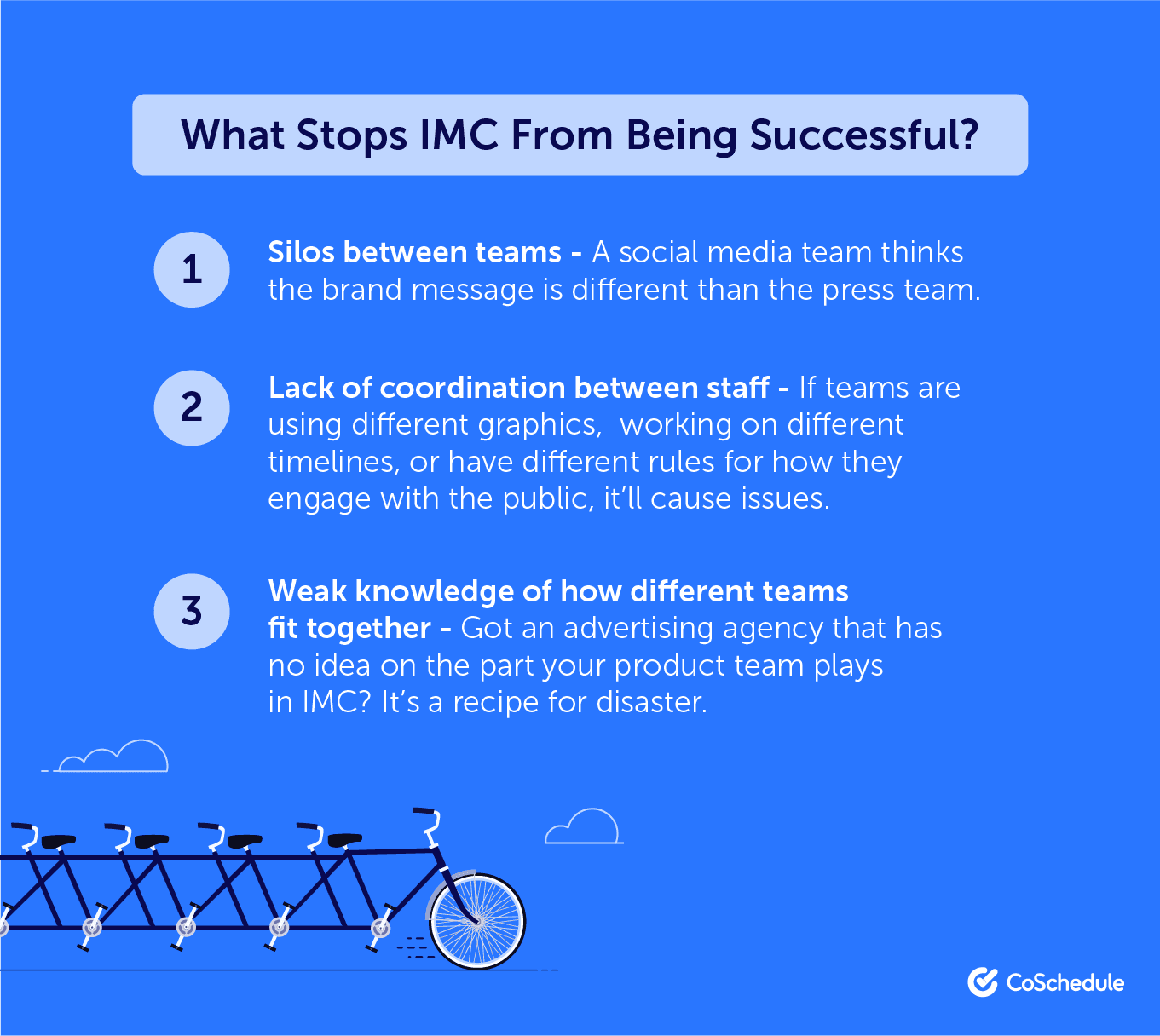How To Make The Best Integrated Marketing Communications Campaign In The World With Multiple Teams
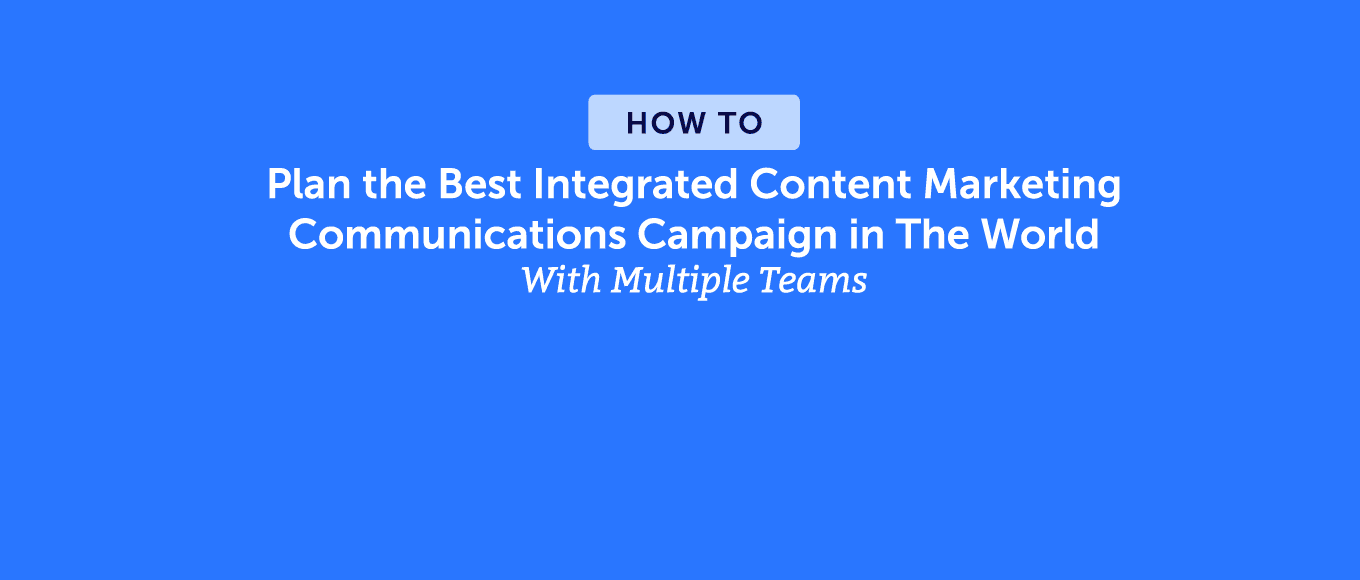 You’re pushing out new marketing campaigns on a monthly basis.
Sure, it’s bringing results in terms of direct sales and ROI.
Brand wise? There’s not much impact.
Brand awareness is notoriously hard to track. Small things add up over time, and it’s fairly unrealistic to expect that one campaign will cement you in the Hall of Fame for brands in your industry.
However, there is one thing that can nudge you closer to tons of brand recognition: an integrated marketing communications campaign.
In this guide, we’ll share:
You’re pushing out new marketing campaigns on a monthly basis.
Sure, it’s bringing results in terms of direct sales and ROI.
Brand wise? There’s not much impact.
Brand awareness is notoriously hard to track. Small things add up over time, and it’s fairly unrealistic to expect that one campaign will cement you in the Hall of Fame for brands in your industry.
However, there is one thing that can nudge you closer to tons of brand recognition: an integrated marketing communications campaign.
In this guide, we’ll share:
- What integrated marketing communications (IMC) is
- Why IMC is important
- A real-world example of an IMC campaign
- How to draft an IMP plan
How to plan the best integrated content marketing communications campaign in the world with multiple teams.
Click To TweetGrab Your Free Integrated Marketing Communications Template Bundle
Before we get started, we’ve created a template bundle to help you implement your new integrated marketing communications plan. You’ll get:- An integrated marketing communications campaign proposal Word Doc template to help you get every stakeholder on board.
- A campaign execution and launch timeline Excel spreadsheet template to help you plan when your resources will complete the content within your project.
- A marketing workflow process checklist to help you translate content into efficiently delegable tasks your resources will execute.
What is Integrated Marketing Communications?
Integrated marketing communications is the strategy a business uses to make a brand experience and message consistent across several channels. That might be across:- Social media
- Press releases
- Sales promotion
- Direct marketing campaigns
- TV and billboard ads
- Radio commercials
Why Does Integrated Marketing Communications Matter?
Now that we know what an integrated marketing communications strategy is, you might have one question on your mind: “Why do I actually need one?” There are tons of reasons. The first: brand awareness and recognition. Increasing brand awareness is the top goal for B2B marketers, with over 86% saying it’s their main goal for the upcoming year. It even beats educating customers and building credibility. Your target audience will need to see your brand across several media channels between 5 to 7 times before they even remember your brand — never mind purchase off the back of that recognition. An integrated marketing communications plan means your brand is consistent. If customers see the same brand messaging across several platforms, it can lead to average revenue increases of 33%. See? Told you there were reasons to have one.Your target audience will need to see your brand across several media channels between 5 to 7 times before they even remember your brand.
Click To TweetWhat Do IMC Campaigns Typically Include?
Wondering what an integrated marketing communications campaign needs to include? Remember, this marketing strategy enforces a consistent message across various channels, platforms, and formats. That means a campaign usually includes:- Social media content for Twitter, LinkedIn, and Facebook
- Content marketing assets, such as blog posts, case studies, and videos
- Adverts, including social media ads, billboards, and direct mail ads
- Visual assets such as logos, social media images, and infographics
- Public relations content, such as press releases and brand statements
What Stops IMC From Being Successful?
Unfortunately, not every integrated marketing communications strategy goes to plan. Things can get lost in translation — and cause inconsistencies across platforms — when you’re making one of these mistakes:- Silos between teams. A social media team thinks the brand message is different than the press team. Each works in silo without collaboration or communication. What happens? Inconsistencies.
- Lack of coordination between staff. Speaking of working across multiple marketing departments, all staff need to be coordinated. If teams are using different graphics, working on different timelines, or have different rules for how they engage with the public, it’ll cause issues.
- Weak knowledge of how different teams fit together. Got an advertising agency that has no idea on the part your product team plays in IMC? It’s a recipe for disaster. Everyone needs to know how each department works together to launch a single campaign.
A Real-World Example of an IMC Campaign
Want to see an integrated marketing campaign in action? Drift is a textbook example. They’re a B2B revenue acceleration platform, but instead of generic marketing campaigns, they made up the phrase “conversational marketing” and ran an ongoing integrated marketing campaign across various channels. The start was a master guide about conversational marketing on their website, but that came alongside tweets, videos, and Facebook ads: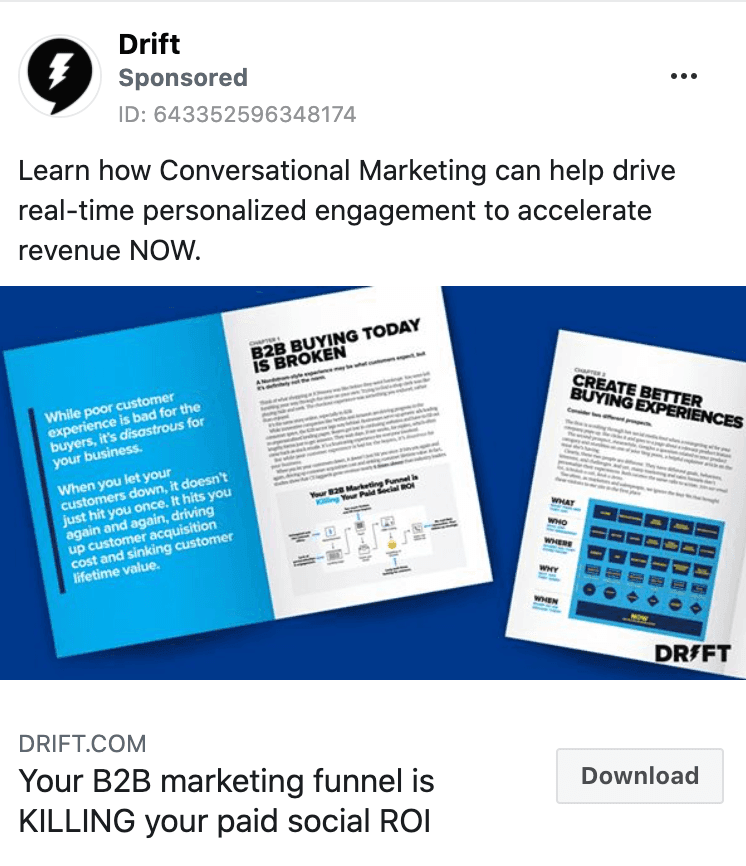 Even a standalone book cemented their position and authority on the topic.
What happened off the back of this integrated marketing campaign?
People started talking about it. The term “conversational marketing” was everywhere, and Drift squeezed the value out of it.
Their master guide has 500+ backlinks from over 300 different websites.
Even a standalone book cemented their position and authority on the topic.
What happened off the back of this integrated marketing campaign?
People started talking about it. The term “conversational marketing” was everywhere, and Drift squeezed the value out of it.
Their master guide has 500+ backlinks from over 300 different websites.
 Drift also takes the top spot for the keyword “conversational marketing” — a term searched by 500+ people per month. That’s not including any keyword variations, of which there are hundreds.
Drift also takes the top spot for the keyword “conversational marketing” — a term searched by 500+ people per month. That’s not including any keyword variations, of which there are hundreds.
How to Draft Your Integrated Marketing Communications Plan in 6 Simple Steps
We know what a good integrated marketing communications plan looks like and the downfalls to avoid when creating yours. Speaking of which, now’s the perfect time to draft your IMC strategy. Your plan will include three, key parts:- A creative brief outlining why you're taking on this project, the audience you're targeting, the verbiage you'll use to attract those folks, and more foundational elements that will help your team understand the purpose of the campaign.
- A content and promotion campaign timeline that outlines the phases of work completed toward the ultimate publish date. This helps you understand when your cross-functional team will complete the work for each piece of content within the campaign.
- A human resources plan your campaign needs to be successful. This includes the names of the individuals you'll need to pull from other teams to get your IMC campaign completed.
1. Write Your Campaign's Creative Brief
Regardless of what type of digital marketing activity you’re planning, the first thing to nail down is the why. Simon Sinek literally wrote a book about it. Ask yourself:- Why are you taking on this campaign right now?
- Why will it be successful?
- Why will your audience prefer your campaign on this topic compared to your competition (i.e. how will yours be better)?
- Setting Goals in Google Analytics.
- Tracking which pieces deliver the highest number toward those goals with a Google Analytics Custom Report.
- Analyzing the qualities within those successful pieces to include content like them in your new campaign.
- Your target audience: Keep it simple; this could be, "{Audience title/role} who have issues with {insert challenge}." If you're feeling the pressure from office bureaucracy for a little more polished understanding of your target market, use this free template to create your own persona and include it in your campaign plan.
- Campaign goal: While you based this campaign on ideas you know have already been successful, this goal isn't necessarily about laying out the "numbers" of what your campaign will generate — though you could include that in your campaign plan, too, if your business needs the data. Instead, write what you aim for your audience to experience. For example, "Attract the right kinds of {audience title/role} who will be interested in {company name's} {product/service}."
- Call to action: One clear call to action per piece gives your audience way fewer distractions. For your integrated campaign, that likely means the same call to action across all pieces. This could be “sign up for your free demo” or “start your 14-day free trial.”
The key to messaging is to nail the language your audience uses to describe their challenges.
Click To Tweet- Audience and/or customer user surveys: Comb through customer surveys to understand the actual words people use to describe their challenges. Use a marketing tool, like Typeform or SurveyMonkey, to do this, asking one simple question: "Why did you hire/choose {company name}?" Open-ended questions give your audience the freedom to describe the why, which gives you the literal words they use — making for excellent marketing copy.
- Blog post comments: If you publish blog posts, your audience likely leaves comments through your comment system, like Disqus. Those are GOLD for you to respond back and ask why they found the information helpful. Use their words in your marketing copy.
- Social media interactions: When someone shares your content or mentions you, you have the opportunity to respond. In that response, you can ask, "Why?" Why did they share? What challenge were they facing that your content helped them solve? Make a note of any sentences you see crop-up often.
- Why does my audience care about this new service? Because {insert benefit they get}.
- Why does my audience care about this {benefit from previous answer}? Because {insert benefit they get}.
- Why does my audience care about this {benefit from previous answer}? Because {insert benefit they get}.
- Why does my audience care about this {benefit from previous answer}? Because {insert benefit they get}.
- Why does my audience care about this {benefit from previous answer}? Because {insert benefit they get}.
- Unique flavors
- Healthy ingredients
- Environmentally conscious
- “Healthy cookies”
- “Peppermint cookies”
- “Eco-friendly dessert businesses”
- Overview
- Why do this campaign *right now*?
- Why will it be successful?
- Why will your audience love it?
- Your target audience
- The goal
- Call to action
- Speaking points
- Keywords
A Creative Brief Example From CoSchedule
Phew. That's a lot to take in. Grab your free creative brief template (the one that came in your kit that complements this blog post) to get started. Then, follow along with this example, if you find it helpful. Campaign Summary An eCommerce research project intended to attract small business owners wanting to launch their own online store. Details- Who is this for? Small business owners and “makers” that are currently selling on Etsy, farmer’s markets, etc.
- What problem does this solve? {Brand} is finding it difficult to convince designers, makers, and small business owners of the benefits to creating their own webshops, rather than selling via Etsy. This report will provide {brand} with original data to use throughout the year and will highlight the benefits of setting up an eCommerce site.
- What is the goal? The primary goal is to increase interest in using {brand} as the go-to eCommerce platform. This will help position {brand} as the best solution for setting up an eCommerce website. We will create a comprehensive research report that aims to convert 5,000 new paid users by the end of 2021.
- How will we measure it? This report will be measured based on the number of new accounts generated from gated downloads.
- Write survey questions
- Distribute survey
- Analyze data
- Write content for the report
- Design PDF
- Prepare promotion strategy
- Measure
- PR, Graphic Design, Social Media, Analytics, Content Marketing, Email Marketing, and SEO
2. Plan Your Content, Promotion, and Resources
Remember how we mentioned that an integrated marketing communications team needs to work together across different departments? At this point, you’ll plan how you use each department. Simply start by looking at a list of all of the different types of content you could possibly include in your campaign. There are over 100 to choose from. You can check out the complete list of content ideas. Literally copy them from that blog post and paste them into the “Content + Promotion Checklist” tab (column A) in your integrated marketing communications template spreadsheet. Now that you know all of the content you'll create as part of the campaign, you likely have a pretty good grasp on whose help you'll need to execute each piece.
Think of names and resources (both internal and external) of the folks who need to be involved.
Think of the executioners — the doers — on the Graphic Design, PR, Advertising, Digital Media, Social Media, Content, SEO, Product Marketing, and your team. Everyone with even a slight marketing aspect to their role should be considered.
Write those names in column B in the “Content + Promotion Checklist” tab in your template.
At this point, you're just getting acquainted with who you'll need help from to make your project successful. This gives you a framework to have a conversation with each of their managers to get their permission to borrow time from their talent.
Generally speaking, the more often a specific name pops up, the more involved they'll need to be in the project.
Later, after you have the conversation with each team member’s manager, you'll figure out how much time that person will need to contribute to make the project a success.
It's a little early in the process to start with the math here, but knowing who you’ll need, and how much of an impact they’ll have on the project, is a good starting point.
Now that you know all of the content you'll create as part of the campaign, you likely have a pretty good grasp on whose help you'll need to execute each piece.
Think of names and resources (both internal and external) of the folks who need to be involved.
Think of the executioners — the doers — on the Graphic Design, PR, Advertising, Digital Media, Social Media, Content, SEO, Product Marketing, and your team. Everyone with even a slight marketing aspect to their role should be considered.
Write those names in column B in the “Content + Promotion Checklist” tab in your template.
At this point, you're just getting acquainted with who you'll need help from to make your project successful. This gives you a framework to have a conversation with each of their managers to get their permission to borrow time from their talent.
Generally speaking, the more often a specific name pops up, the more involved they'll need to be in the project.
Later, after you have the conversation with each team member’s manager, you'll figure out how much time that person will need to contribute to make the project a success.
It's a little early in the process to start with the math here, but knowing who you’ll need, and how much of an impact they’ll have on the project, is a good starting point.
Knowing who you’ll need, and how much of an impact they’ll have on the project, is a good starting point.
Click To Tweet3. Create Your Campaign Workflows and Launch Timeline
The process to create each piece of content usually looks something like this:- Write/Record
- Design
- Edit
- Proof/Approve
- Launch
- Promote
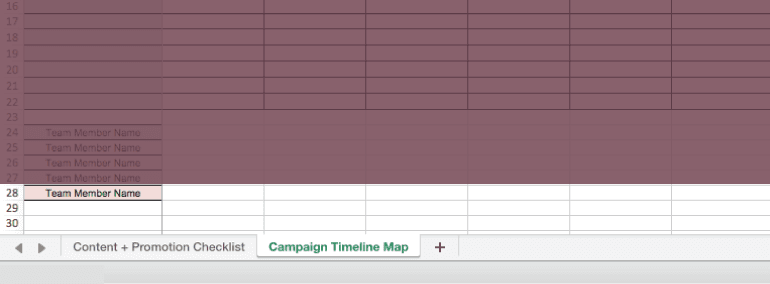 Some bonus tips to make this stage easier:
Some bonus tips to make this stage easier:
- Start with one piece at a time. Write the content idea in column A.
- Think of weeks and time in a generic sense right now. In the first week of taking on this specific piece, what phases will be completed? Start with column B (i.e. week 1) for all pieces for the moment.
- Match the team member name with a color, so you can easily see how much is on someone's plate in a given week at a glance. This is optional, but it seriously makes things easier because you’ll never delegate too much to a single person to complete in a single week. Chances are, that would cause delays in the entire campaign execution process.
- Move the starting weeks of content creation to stagger the workload. You want this plan to be as realistically doable as possible. Simply copy every phase of content creation starting in column B (i.e. week 1) to the last column with execution in it and move it all back at least one week. You'll stagger all of the content this way.
- Note: Execute the most important content first. That way, if things hit a delay or snag of some kind, you have the option of cutting less important things to still hit the main project deadline.
A Campaign Timeline Map Example
Wondering what this timeline looks like with data filled in? Let's take a look at an example campaign timeline, so you can see what this looks like in practice: You'll note this looks different than your spreadsheet template.
We’ve made a few extra tweaks to make it even easier.
Each week is split into two columns, so you can see:
You'll note this looks different than your spreadsheet template.
We’ve made a few extra tweaks to make it even easier.
Each week is split into two columns, so you can see:
- Who needs to complete their work at the beginning of the week?
- Who needs to wrap up things at the end?
4. Get Approval From the Talent's Management
Now, for the hardest part of the entire integrated marketing communications campaign process. You’ve already gotten approval from the marketing manager (yourself). Next, you need approval from other department managers to push forward with the campaign. Getting higher-ups on board and on your side from the get-go makes collaboration easier among your co-supervisors and cross-functional teams as you begin executing. You’ll get their permission to lend time from their departments. The good news? You've already done the hard work! Now, it's just time to show each of the cross-functional team members' managers what you plan to do and set some expectations of what you'll need from the talent. Easy. Start by scheduling a one-on-one meeting with each teams' supervisor. If one of these folks is a bureaucratic pest, their depressingly contagious opinions won't infect the supervisors who'll be cool with your IMC proposal. One-on-ones give you the opportunity to deflect that behavior on a person-by-person basis. Set up 30-minute one-on-ones with the:- Graphic Design Lead
- Head of PR
- Advertising Manager
- Multimedia Supervisor
- Search Engine Optimization (SEO) Manager
- Social Media Manager
- Head of Product Marketing
Schedule 30-minute, one-on-one meetings with team supervisors to get everyone onboard with your campaign.
Click To Tweet- 5 minutes: Show your creative brief. This is high-level stuff. Begin by saying, "To start, I simply want to fill you in on why we're taking on this project." Then literally walk them through the creative brief.
- 5 minutes: Show the content and promotion checklist. After they have an understanding of why you're tackling this campaign now, they will likely want to know what you need help creating. Showing off the checklist immediately after the campaign overview gives your co-supervisors a quick overview of every piece of content you plan to publish as part of the project.
- 5 minutes: Gather content and promotion feedback. Chances are, your co-supervisors have feedback the moment they see all of the content you plan to create for the campaign. Give them the opportunity to provide it. Do not push back at this point, but play the role of a listener. You're asking to use their resources to execute these projects; therefore, they likely have domain expertise on certain pieces you can learn from.
- 5 minutes: Show your campaign timeline map. Since the timeline map breaks down when you expect specific team members to complete phases of content development, it makes sense to show this to your co-supervisors after they see the general content and promotion checklist. This is ultimately the biggest part of the meeting; it demonstrates how often you'll need to tap into your co-supervisors' resources.
- 10 minutes: Gather feedback on the campaign timeline map. Your co-supervisors likely have experience with specific content workflows, the amount of time it takes to complete each task, and so on. Gather that information now, so you can break each piece of content into easily delegable, task-based workflows you'll use to kick off the campaign. You'll learn more on that in a bit.
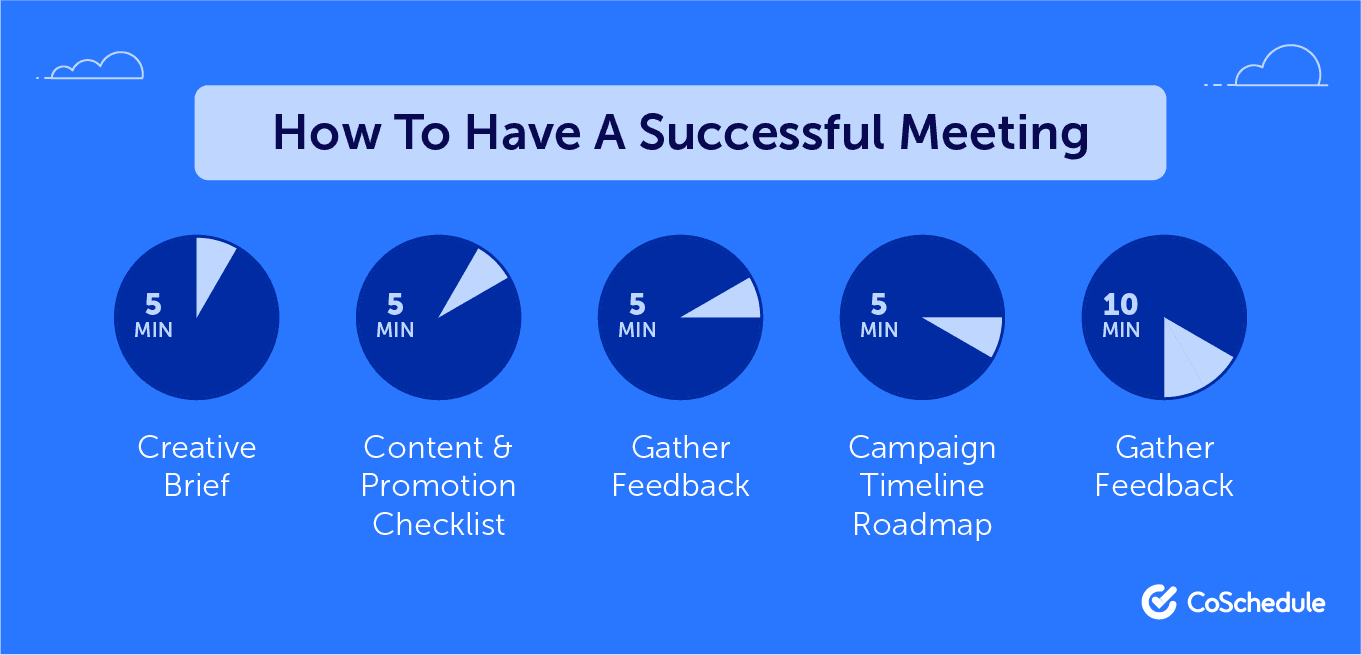 Your goal is to leave the meeting with two things:
Your goal is to leave the meeting with two things:
- An actionable to-do list of optimizations you'll make to the campaign's creative brief, content and promotion checklist, and timeline map based on each supervisors' feedback.
- Your yes: Confirmation that if you proceed forward with the planned optimizations, you will get the resources you need from each supervisor to complete the IMC campaign. At the end of your meeting, ask, "If I incorporate the feedback you suggested, will you support this campaign and provide the resources we need to make it successful?"
5. Break Each Piece Into Delegable, Task-Based Workflows
Each piece of content within your integrated marketing communications campaign needs a workflow. In basic terms: you’ll break each piece of content into clear tasks you'll assign to individuals. Here's a quick overview of how to break down a single piece into delegable tasks. You'll follow this process one time per every piece in your campaign:- List every step that needs to be completed before you'd consider the piece complete. Don't limit yourself at first; write down everything — including writing, designing, promoting, approvals, and anything else you typically do to execute a piece like this.
- Cross out the steps you don't need to do. Nobody likes extra work. Delete the tasks that:
- Belong in other workflows.
- Have always been done simply because you've always done them that way, but don't necessarily make the content any more successful.
- Are outdated.
- Exist purely to serve office bureaucracy.
- Combine similar steps together into single tasks. For example, if you listed something like "Write the content" and "Write the headline" as separate steps, you can now combine them into a single task to assign to a single person: "Write the content". At this point, write what the definition of this task’s completion is and set your expectations. For example, "This task involves writing the body copy, headlines, and {insert expectation}." These things must be complete before checking the task as complete because this is now the definition of “done”.
- Determine who will complete each task. Reference your content and promotion checklist to see the list of names involved in the project. Assign those folks specific tasks with definitions of what “done” means.
- Figure out how long it will take to complete each task. Your meetings with the talents' supervisors gave you the opportunity to discuss workflow and time involved in content production. Use that information here to provide enough time to complete each task. Alternatively, you could informally ask your talent for their input on how long they'd estimate it would take them to complete each task to make your due dates as realistic as possible, or look in your time tracking software for historical data. Tons of options.
- Plan the due dates for each task — starting with the last task in the workflow: How many days before publication should it be due? From there, you can map backward from the last task in the list to the first to know when you will start working on the piece. You can also use your campaign's timeline map to help you understand when to assign tasks, since you've already mapped the phases of content production for each piece, generally speaking.
- Delegate each task to a specific team member with a clear due date. There are three things to get right:
- Notify each team member of every task they own the moment you assign them.
- Remind each team member before the task is due, so they have the opportunity to complete it on time, if they haven't already started.
- Give them a method to collaborate and communicate with others executing the project (NOT via email, where things get lost).
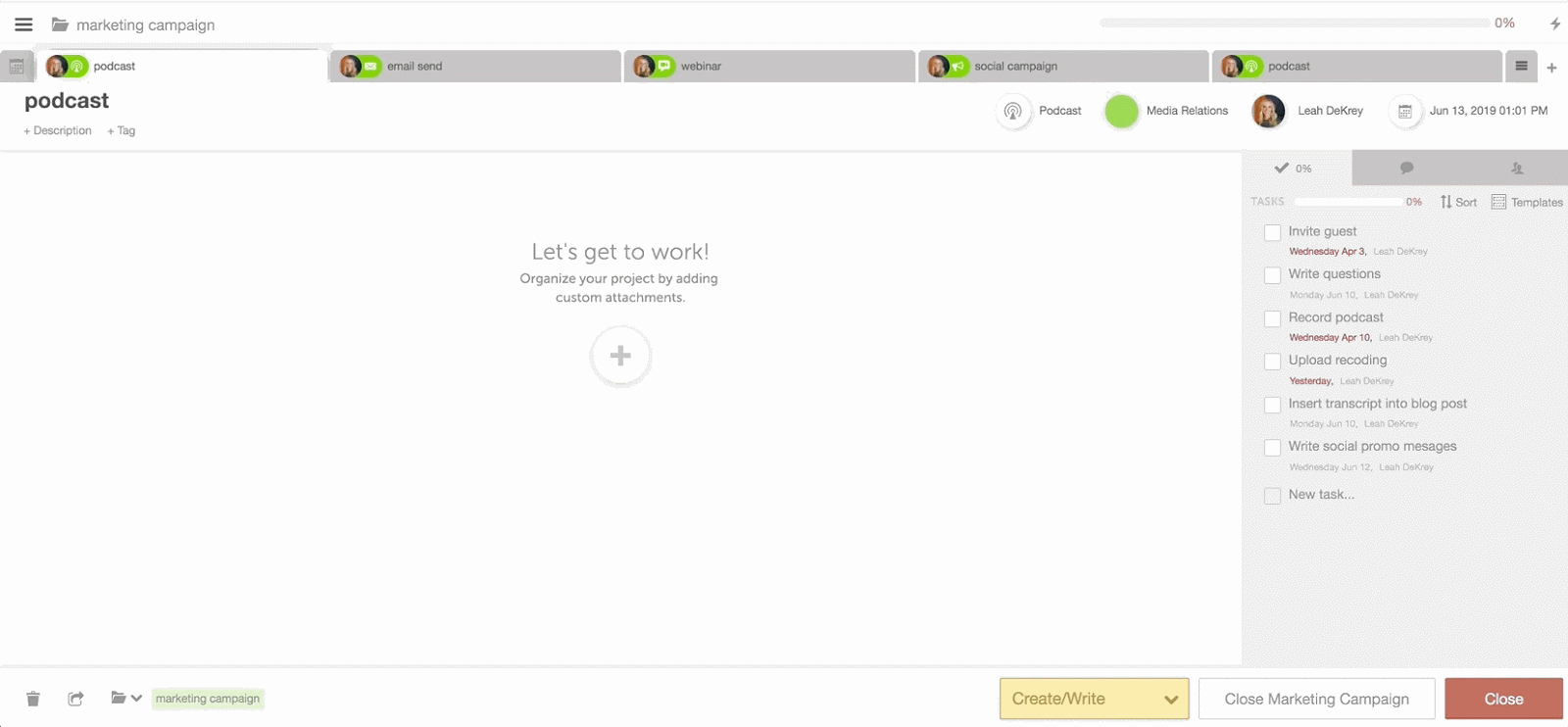 It's ready for you to re-use for every future project. No more time wasted planning due dates and delegating tasks. It does all the work for you.
It's ready for you to re-use for every future project. No more time wasted planning due dates and delegating tasks. It does all the work for you.
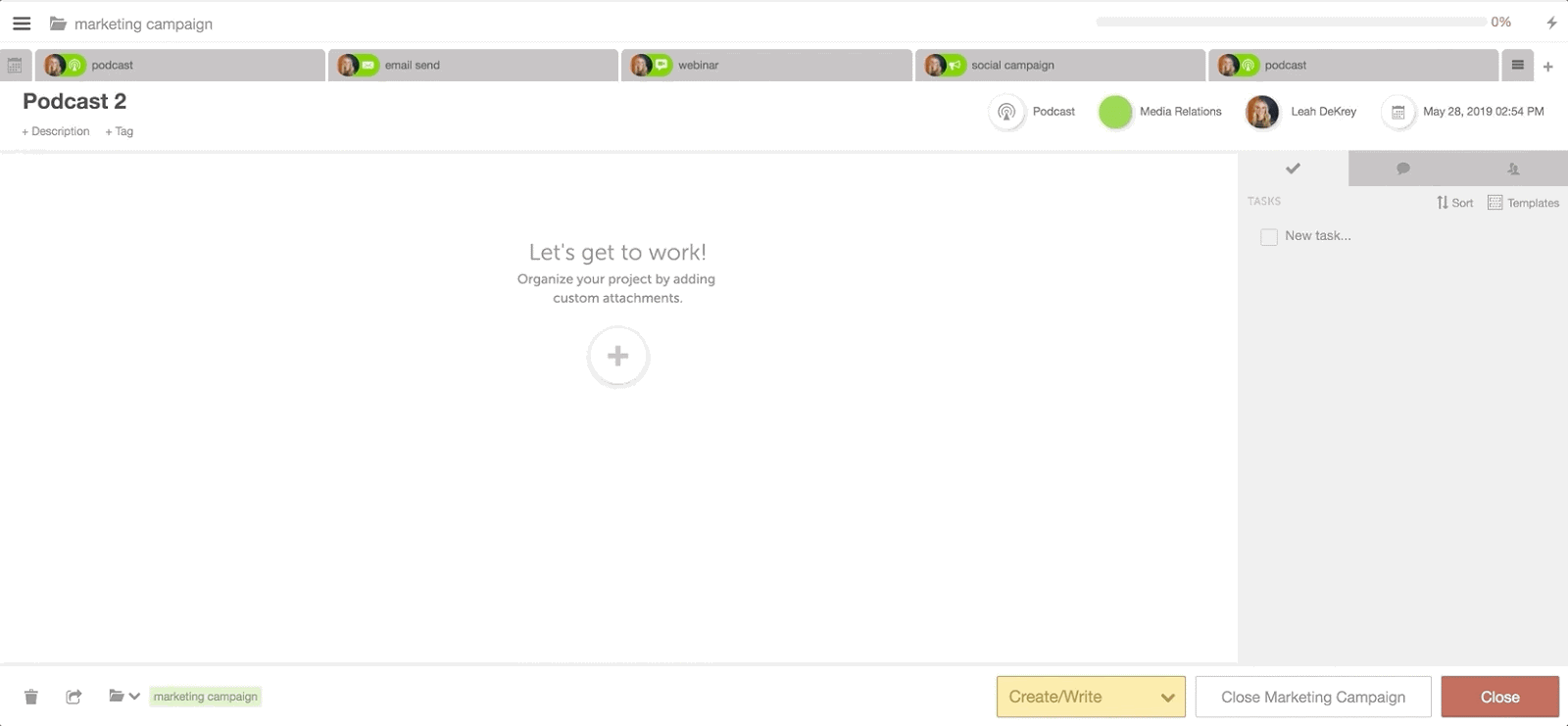
6. Execute and Keep Everything On Track
Boom! You’ve got your integrated marketing communication ducks in a row. The only thing left is to execute your plans and turn your campaign into reality. To do this, we recommend using the Marketing Campaigns in CoSchedule. With it, you’ll be able to:- Plot out every publish date for every piece.
- Create workflows for every piece.
- Automatically notify each team member of every task they need to complete.
- Automatically remind each team member they have tasks to complete before they miss their due dates.
- Collaborate on each piece of content within your campaign without overwhelming email strings or lost Slack threads. No extra communication tools needed — unless you really wanted them.
- Give every stakeholder one place to see everything.
